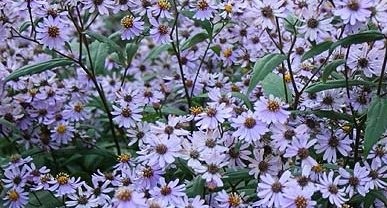
Aster macrophyllus 'Twilight' - Twilight big leaf aster (aka Eurybia x herveyi 'Twilight')
Aster 'Twighlight' is new to our New Moon Nursery production for 2018 and will be available to ship 07.01.18 and beyond.
FIRST IMPRESSIONS: Aster macrophyllus ‘Twilight’ begins the growing season as a rosette of large heart shaped basal leaves. For a month or so plants look like an attractive coarse textured groundcover. Upright stems elongate from the basal leaf mass and bear open flat topped clusters of lavender blue blooms in late summer and fall. Mildew resistant plants prosper in morning sun or dappled shade and in average well drained soils.
HABITAT & HARDINESS: The parent species Aster macrophyllus occurs through Eastern North America except for a few states in the Southeastern United States. The range extends through the northeastern deciduous forests of New England and south through the Blue Ridge Mountains.
Habitats include open beech-maple woodlands, sandy oak savannas, wetland hummocks, shaded sand dunes, woodland borders and shaded road banks. Plants are more likely to occur in undisturbed sites and are common in Northwoods plant communities except for bottomland and other wet woodlands.
Plants are hardy from USDA Zones 3-9.
PLANT DESCRIPTION: After a winter nap, Aster macrophyllus ‘Twilight’ emerges from small colonies of underground rhizomes. Thus begins the groundcover phase where plants consist of robust rosettes of 4” to 8” toothed heart shaped leaves.
Plants transition from groundcover to wildflower when erect stems emerge. The stems usually develop a red-purple color and bear tiny sessile leaves.
Stems are topped with flat topped branched flower clusters from late summer until mid-fall. The large flower heads consist of a ring of lavender blue petal-like ray flowers. The rays surround a central cluster of yellow disc flowers. By the time the flowers are produced, the basal leaves have disappeared.
Flower heads are frequented by bees and butterflies.
Plants grow 2.5-3’ tall with 2-3’ spread.
CULTURAL & MAINTENANCE NEEDS: Aster macrophyllus ‘Twilight’ grows best in full sun to part sun with average well drained soil. Plants will tolerate part shade but if shade is dense, they may not flower.
Plants are somewhat drought tolerant. They prefer average mesic soils that are not too dry or too wet. Indigenous plants are most likely to be found in rich loam or sandy loam soils.
LANDSCAPE USES: This is a good choice for a Wildlife Garden or Shade Garden. Plants are also used as Butterfly Nectar Plants, Butterfly Host Plants or as part of a Groundcover, Grouping or Mass Planting. Aster macrophyllus ‘Twilight’ has Showy Blooms and can be used in Cottage Gardens, Water-wise Landscapes, Low Maintenance Plantings and Perennial Borders.
COMPANION & UNDERSTUDY PLANTS: At woods edge try pairing Aster macrophyllus ‘Twilight’ with Eupatorium colestinum, Heliopsis helianthoides and Solidago caesia.
Aster divaricatus, Aster macrophyllus or Aster cordifolius can be substituted if this selection is not available.
TRIVIA: Many of the established Latin names of Aster spp. were changed due to DNA and genetic research findings. So Aster macrophyllus ‘Twilight’ is now known as Eurybia x herveyi 'Twilight'.
Plants host caterpillars of the Pearl Crescent Butterfly. Silvery Checkerspot Butterfly and several species of moths.
Aster macrophyllus ‘Twilight’ is similar in appearance to Aster divaricatus and Aster cordifolius. The main differences are that A. divaricatus has fewer ray florets with no lavender color and leaves that are only on the stems rather than basal. A. cordifolius has rounded rather than flat topped flower clusters.

Mev Jacoba Pretorius at Keep Ptemotions cc
6yBeutiful must be a plesure working there?